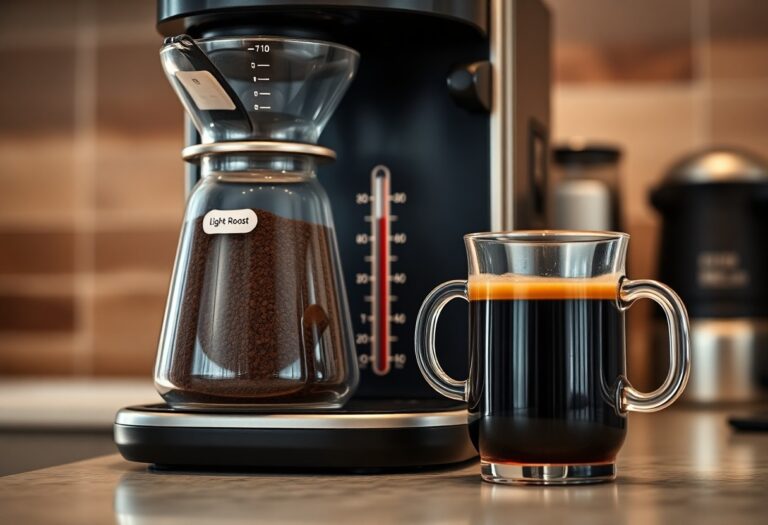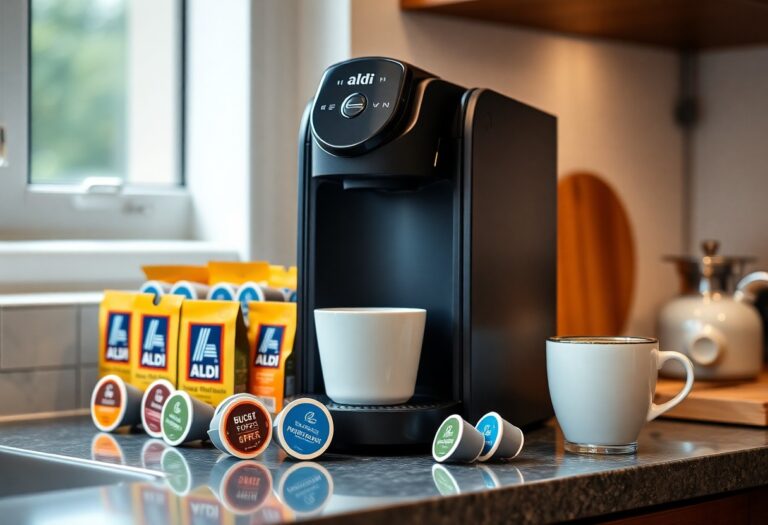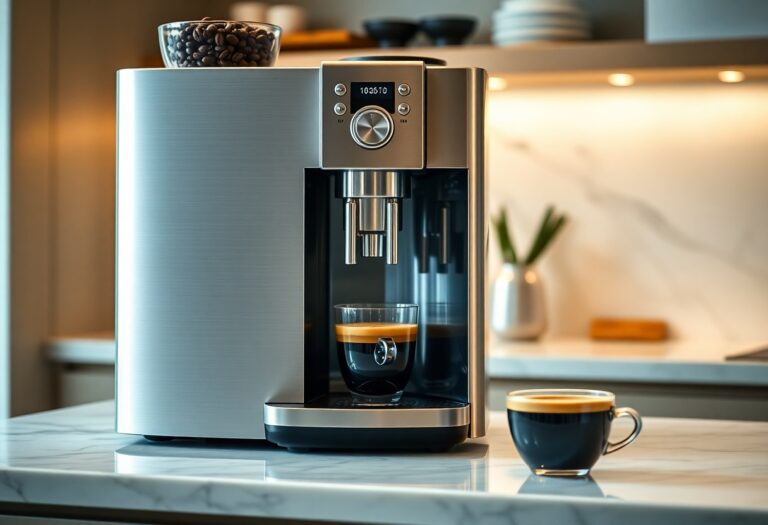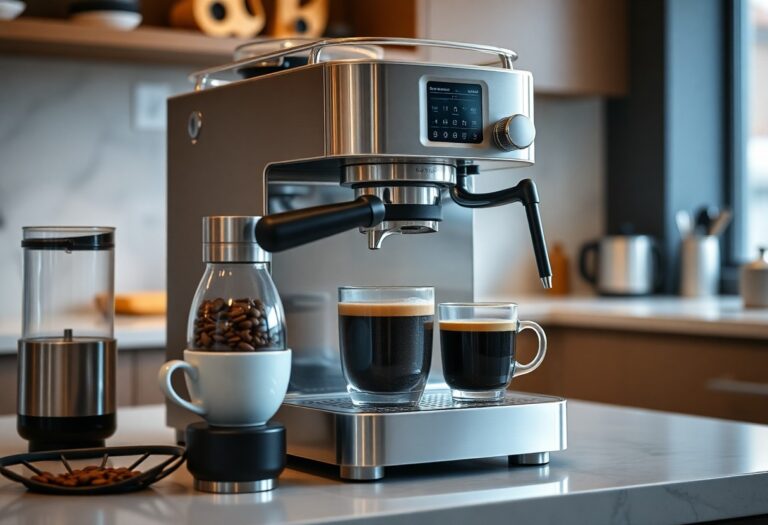What Coffee Machine is Best for Iced Coffee – Cold Brewing
It’s crucial to choose the right coffee machine if you want to enjoy the refreshing taste of iced coffee through cold brewing. With so many options available, you might feel overwhelmed, but understanding your needs can lead you to the perfect machine for your kitchen. Look for machines that offer ease of use and consistent flavor extraction, ensuring you can enjoy your chilled beverage without hassle. In this post, you’ll discover various types and features to consider, helping you make an informed decision for your iced coffee experience.
Key Takeaways:
- Cold brew coffee makers are ideal for iced coffee, as they steep coarsely ground coffee in cold water for several hours, producing a smooth, less acidic brew.
- Look for coffee machines with adjustable brewing settings to customize strength and flavor, catering to personal preferences.
- Consider models that allow for easy filtering, as removing grounds after brewing is important for achieving clarity in the final iced coffee product.
- Some coffee machines come with built-in coolers or ice compartments, which can enhance the overall brewing process and final drink experience.
- Portability and ease of cleanup are key factors; compact and user-friendly designs can make the cold brewing process more convenient and enjoyable.
The Essential Components of Cold Brewing Machines
A well-designed cold brewing machine should include a few key components to elevate your iced coffee experience. Look for a brewing chamber that holds coffee grounds, a filter system for smooth extraction, and a pitcher or carafe for easy storage. Many machines also feature adjustable settings for strength and brewing time, enabling you to customize your drink precisely to your liking. Compatibility with different coffee types can also enhance versatility, allowing for experimentation with flavors and textures.
Understanding Brewing Time and Temperature
Brewing time and temperature significantly influence the final taste of your cold brew. Cold brewing generally requires a longer steeping time, typically around 12 to 24 hours, compared to traditional brewing methods. During this process, cold water extracts flavors more gently, often leading to a smoother taste profile. However, using water that is too cold can hinder flavor extraction, while slightly rising temperatures can speed up the process without compromising taste.
Brewing Time and Temperature Breakdown
| Brewing Aspect | Details |
|---|---|
| Brewing Time | 12 to 24 hours for optimal flavor extraction |
| Temperature | Cold or room temperature water is best |
Importance of Brew Strength and Flavor Profile
The strength of your cold brew directly impacts its flavor profile. Higher coffee-to-water ratios create a more concentrated drink, amplifying bold flavors and reducing acidity. Conversely, a more diluted brew might taste weak but can be refreshing and smooth. Adjusting these ratios allows you to target your preferences, making experimentation a fun and rewarding part of mastering cold brewing.
Your preference for brew strength can significantly impact your iced coffee enjoyment. Most cold brew aficionados lean towards a ratio of 1:4 (coffee to water) for a robust flavor, while others may prefer a lighter mix at 1:8. Understanding how these strengths affect the natural flavor notes in your coffee—such as chocolatey richness or berry-like brightness—enables you to tailor your drink. A balanced profile enhances sweetness and mellows out any bitterness, creating a delightful experience that can be enjoyed plain or transformed into creative coffee beverages.

Comparing Popular Cold Brew Machines on the Market
| Model | Price Range |
| Takeya Cold Brew Maker | $30-$35 |
| Filtron Cold Brew Coffee Maker | $40-$50 |
| Oxum Cold Brew Maker | $50-$60 |
| KitchenAid Cold Brew Coffee Maker | $100-$120 |
For a detailed analysis of cold brew coffee makers, check out The 6 Best Cold Brew Coffee Makers, Tested & Reviewed. Each model has unique features tailored to different brewing preferences and capacities, ensuring you find the right fit for your iced coffee habit.
Top Recommendations for Home Brewers
If you’re brewing cold coffee at home, popular options like the Takeya Cold Brew Maker and Filtron are often recommended. They offer excellent flavor extraction and user-friendly designs. Takeya stands out for its affordable price, while Filtron’s large capacity makes it ideal for serving gatherings. Both ensure you have a refreshing supply of cold brew coffee ready to enjoy.
Features That Make a Difference
Choosing the right cold brew machine means considering specific features. Look for machines with sturdy materials, filter options for easy cleaning, and unique designs that facilitate brewing. Additionally, some models come with built-in pitchers or storage for finished brew, making serving a breeze. Additionally, adjustable brewing times can cater to taste preferences, helping you achieve the perfect balance of strength and smoothness.
For instance, filters made from stainless steel or ultra-fine mesh improve the clarity of your cold brew, preventing sediment. A brewer with an adjustable brew time allows you to customize the strength, so if you favor a more concentrated cup, you can steep for longer. The ease of cleaning, often overlooked, should never be underestimated because a complicated setup often discourages daily use. Overall, the right features can enhance your cold brewing experience significantly.
The Science of Extraction: How Cold Brewing Works
Cold brewing is a process that extracts flavors from coffee beans without the use of heat, which can alter taste profiles. Instead of rapid extraction seen in hot brewing, cold brewing relies on steeping coarsely ground coffee in cold water for an extended period, typically 12-24 hours. This slow extraction results in a smoother, less acidic coffee concentrate that retains the rich flavors of the beans while enhancing their natural sweetness.
The Role of Water Temperature and Coffee Grind Size
Water temperature and coffee grind size significantly impact the cold brewing process. Below is a summary of their effects:
| Factor | Impact |
| Water Temperature | Colder temperatures reduce extraction speed, resulting in a smoother flavor profile |
| Coffee Grind Size | Coarse grinds prevent over-extraction; finer grinds can lead to bitterness |
Balancing Brew Ratio for Optimal Flavor
The brew ratio, or the proportion of coffee to water, is vital for achieving optimal flavor in cold brew. A general recommendation is a 1:4 or 1:5 coffee-to-water ratio to produce a concentrated coffee that can be diluted later with water or milk for serving.
Adjusting the brew ratio allows you to customize your cold brew experience. For instance, using a stronger 1:3 ratio yields a bolder coffee, while a 1:5 ratio results in a more refreshing drink. Experimenting with these ratios can help you discover your preferred taste balance, enhancing the freshness and crispness that cold brews are known for.
Advanced Techniques for Iced Coffee Enthusiasts
For those who take their iced coffee seriously, venturing into advanced techniques can unlock new flavor profiles and personalized brews that cater precisely to your taste. Here are some methods that will elevate your cold coffee experience to the next level:
- Explore different brewing times for various strengths.
- Try adding spices like cinnamon or nutmeg for extra flavor.
- Experiment with ice cubes made from coffee instead of water.
- Incorporate different milk types, such as oat or almond, for a unique twist.
- Use flavored syrups or exotic sweeteners like honey or agave for complexity.
| Technique | Description |
|---|---|
| Brewing Time | Adjusting brewing time can change the concentration and flavor intensity. |
| Spices | Adding spices can enhance the flavor without needing more sugar. |
| Coffee Ice Cubes | Prevent dilution while maintaining flavor with frozen coffee instead of water. |
| Milk Types | Different milk options alter the texture and taste of your coffee. |
| Flavor Additives | Experimenting with sweeteners can create diverse and interesting beverages. |
Experimenting with Coffee Beans and Flavor Additives
Choosing the right coffee beans is vital for crafting perfect iced coffee. Single-origin beans provide distinctive flavors, while blends offer more complexity. Try incorporating flavored additives like vanilla or caramel syrups to create a customized drink that reflects your personal taste. Roasting levels also play a significant role; medium roasts yield a balanced flavor while dark roasts can impart a more robust, bold experience.
Customizing Brew Method for Personal Preferences
You have the power to tailor your brewing method to suit your palette. Adjusting key factors such as water temperature, grind size, and brewing ratio can significantly influence the taste of your cold brew. Consider a coarser grind for a smoother flavor or a finer grind for a more intense profile. Additionally, experimenting with steeping times will help you determine the optimal extraction for your preferred taste.
Personalizing your brew method opens up a world of possibilities. You can balance strength and smoothness based on how long you let your coffee steep. For instance, a longer steeping time can yield a concentrated brew with richer flavors, while a shorter time might result in a lighter, more refreshing drink. An ideal starting point is a 1:4 coffee-to-water ratio, which can be adjusted according to your taste preferences. By fine-tuning these variables, you ensure every cup aligns perfectly with what you enjoy most.

Maintenance Tips for Longevity and Quality
To ensure your iced coffee machine remains in optimal condition, regular maintenance is key. Following a few simple tips can significantly enhance the longevity and quality of your coffee. Consider these points for effective upkeep:
- Rinse and clean the components regularly
- Use filtered water to prevent mineral buildup
- Store machine parts separately to avoid damage
- Check for wear and tear on seals and filters
After implementing these steps, your machine should consistently deliver high-quality iced coffee.
Proper Cleaning and Care for Cold Brew Machines
Cleaning your cold brew machine involves disassembling the parts and rinsing them thoroughly. Use a soft sponge with mild soap to avoid scratching any surfaces. Rinse well to eliminate soap residues, which can spoil the flavor of your coffee. For stubborn stains, vinegar or baking soda can be effective solutions. Regularly replacing filters and gaskets will keep your machine running smoothly and ensure every brew is fresh.
Troubleshooting Common Issues
Should your cold brew machine malfunction, identifying common problems can save time and frustration. Issues may include leaks, slower brewing times, or off-flavors in your coffee. A leak often stems from improper assembly or worn-out seals. If brewing takes too long, check for clogs in the filter. Should your coffee taste off, consider cleaning the machine more thoroughly and using fresh, filtered water.
In case of persistent issues, review the manufacturer’s guide for specific troubleshooting advice. For instance, if a leak is detected, examine all parts for tightness and integrity. Keep an eye on the reservoir to identify any signs of moisture that could indicate wear. Regular maintenance not only avoids future complications but also ensures you enjoy the freshest possible coffee with each brew.
Summing up
To wrap up, selecting the best coffee machine for iced coffee and cold brewing depends on your preferences for convenience, flavor, and batch size. If you want maximum versatility, consider a model with both cold brew and traditional options. Alternatively, a dedicated cold brew maker can simplify the process and enhance flavor, while a French press offers an engaging hands-on experience. Ultimately, your ideal machine should align with your lifestyle and how often you enjoy iced coffee, ensuring that you can indulge in your favorite chilled beverage whenever you desire.
FAQ
Q: What type of coffee machine is best for making iced coffee using cold brewing?
A: The best coffee machines for cold brewing iced coffee are dedicated cold brew coffee makers. These machines typically feature a large brew capacity and a cold brew filter to allow for slow extraction of flavors. Popular brands include Takeya, OXO, and Hario, which are specifically designed to optimize cold brewing and deliver smooth and flavorful iced coffee.
Q: How long does it take to brew iced coffee in a cold brew machine?
A: Cold brewing generally takes anywhere from 12 to 24 hours, depending on your preference for strength and flavor. Machines that automate the process may decrease brewing time slightly, but it is important to allow sufficient steeping to extract the optimal coffee profile. Following the machine’s instructions will help ensure the best results.
Q: Can I use any coffee beans for cold brewing iced coffee?
A: While you can technically use any coffee beans for cold brewing, coarsely ground coffee is recommended for the best results. Light to medium roast beans usually yield a smoother and sweeter flavor profile which is ideal for cold coffee. Experimenting with different blends can also yield unique tastes, so feel free to explore various options!
Q: Is it more economical to make iced coffee at home using a cold brew machine?
A: Yes, making iced coffee at home using a cold brew machine can be more economical in the long run. While the initial investment in a quality cold brew machine may be more than a single coffee shop drink, the cost per serving is significantly lower. Additionally, you can prepare larger batches to serve multiple cups, which translates to savings over time.
Q: Are there cleaning and maintenance considerations for cold brew coffee machines?
A: Yes, cleaning and maintenance are important for ensuring the longevity of your cold brew coffee machine. Most cold brew makers have removable parts that are dishwasher-safe or can be easily rinsed. Regularly cleaning the filter and making sure no coffee grounds remain will help maintain the flavor quality. Follow the manufacturer’s recommendations for deep cleaning and care to keep your machine in optimal condition.







